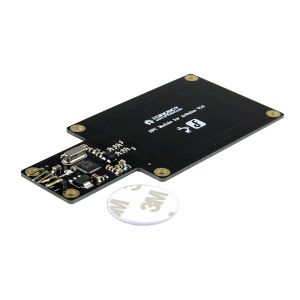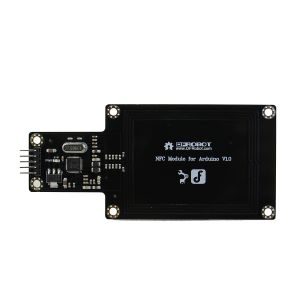Introduction
Near Field Communications (NFC), a contactless, Wi-Fi-lite style tech that could already be in your smartphone, and could soon be a regular feature of your commute. Near Field Communications(NFC) is a set of short-range wireless technologies, typically requiring a distance of 10cm or less, for two devices such as smartphones or the similar things very close to each other to establish communication. Communication is also possible between a NFC device and unpowered NFC chips such as tags, stickers, key fobs and cards which do not require batteries.
The NFC Module for Arduino is designed to extend this powerful feature for your project or application based on Arduino.It integrates a PN532 NFC controller from Philips.The driver interface for this product is UART interface of the microcontroller. So it's possible for you to test it via a USB to UART converter directly. On the other hand, for the applications with microcontroller, the module provides an event for your processor when detects the NFC tags, stickers, key fobs, or cards via high speed serial uart.
Applications
- Contactless payment systems
- Bluetooth and Wi-Fi connections
- Social networking situations, such as sharing contacts, photos, videos or files
- Electronic identity documents and keycards
- Smartphone automation and NFC tags
Specification
- Working Voltage: 3.3v or 5v
- Host interface: UART
- Default Band rate: 115200 bps
- Integrate PN532 NFC controller
- Supports ISO 14443A/MIFARE
- Supports ISO 14443B in reader/writer mode only
- Typical max operating distance for detecting NFC tags from 20 to 50mm depending on the antenna size of the tag
- Serve for contactless communication at 13.56MHz
Connect Diagram
Sample Code
<per> /*
# From Dfrobot wiki: http://www.dfrobot.com/wiki/index.php/NFC_Module_for_Arduino_(SKU:DFR0231) # # Editor : Adrian # Date : 2013.04.18 # Ver : 0.1 # Product: NFC Module for Arduino # SKU : DFR0231 # Description: # When the a card close to the device , the PC will receive the data # Connect the NFC Card's TXD, RXD, GND, +3.3V to Nano's D0RX, D1TX, GND, +3.3V # Or connect the NFC Card's TXD, RXD, GND, +5V to Nano's D0RX, D1TX, GND, +5V
PN532 reads the tag by Arduino mega/Leonardo command list: #wake up reader send: 55 55 00 00 00 00 00 00 00 00 00 00 00 00 00 00 ff 03 fd d4 14 01 17 00 return: 00 00 FF 00 FF 00 00 00 FF 02 FE D5 15 16 00 #get firmware send: 00 00 FF 02 FE D4 02 2A 00 return: 00 00 FF 00 FF 00 00 00 FF 06 FA D5 03 32 01 06 07 E8 00 #read the tag send: 00 00 FF 04 FC D4 4A 01 00 E1 00 return: 00 00 FF 00 FF 00 00 00 FF 0C F4 D5 4B 01 01 00 04 08 04 XX XX XX XX 5A 00 XX is tag. */ //************* start **************
const unsigned char wake[24]={
0x55, 0x55, 0x00, 0x00, 0x00, 0x00, 0x00, 0x00, 0x00, 0x00, \
0x00, 0x00, 0x00, 0x00, 0x00, 0x00, 0xff, 0x03, 0xfd, 0xd4, 0x14, 0x01, 0x17, 0x00};//wake up NFC module const unsigned char firmware[9]={
0x00, 0x00, 0xFF, 0x02, 0xFE, 0xD4, 0x02, 0x2A, 0x00};//
const unsigned char tag[11]={
0x00, 0x00, 0xFF, 0x04, 0xFC, 0xD4, 0x4A, 0x01, 0x00, 0xE1, 0x00};//detecting tag command
const unsigned char std_ACK[25] = {
0x00, 0x00, 0xFF, 0x00, 0xFF, 0x00, 0x00, 0x00, 0xFF, 0x0C, \
0xF4, 0xD5, 0x4B, 0x01, 0x01, 0x00, 0x04, 0x08, 0x04, 0x00, 0x00, 0x00, 0x00, 0x4b, 0x00}; unsigned char old_id[5];
unsigned char receive_ACK[25];//Command receiving buffer //int inByte = 0; //incoming serial byte buffer
- if defined(ARDUINO) && ARDUINO >= 100
- include "Arduino.h"
- define print1Byte(args) Serial1.write(args)
- define print1lnByte(args) Serial1.write(args),Serial1.println()
- else
- include "WProgram.h"
- define print1Byte(args) Serial1.print(args,BYTE)
- define print1lnByte(args) Serial1.println(args,BYTE)
- endif
void setup() {
Serial.begin(9600); // open serial with PC Serial1.begin(115200); //open serial1 with device //Serial2.begin(115200); wake_card(); delay(100); read_ACK(15); delay(100); display(15);
}
void loop() {
send_tag();
read_ACK(25);
delay(100);
if (!cmp_id ()) {
if (test_ACK ()) {
display (25);
delay (100);
}
}
copy_id ();
}
void copy_id (void)
{//save old id
int ai, oi;
for (oi=0, ai=19; oi<5; oi++,ai++) {
old_id[oi] = receive_ACK[ai];
}
}
char cmp_id (void)
{//return true if find id is old
int ai, oi;
for (oi=0,ai=19; oi<5; oi++,ai++) {
if (old_id[oi] != receive_ACK[ai])
return 0;
}
return 1;
}
int test_ACK (void)
{// return true if receive_ACK accord with std_ACK
int i;
for (i=0; i<19; i++) {
if (receive_ACK[i] != std_ACK[i])
return 0;
}
return 1;
}
void send_id (void)
{//send id to PC
int i;
Serial.print ("ID: ");
for (i=19; i<= 23; i++) {
Serial.print (receive_ACK[i], HEX);
Serial.print (" ");
}
Serial.println ();
}
void UART1_Send_Byte(unsigned char command_data)
{//send byte to device
print1Byte(command_data);
- if defined(ARDUINO) && ARDUINO >= 100
Serial1.flush();// complete the transmission of outgoing serial data
- endif
}
void UART_Send_Byte(unsigned char command_data)
{//send byte to PC
Serial.print(command_data,HEX);
Serial.print(" ");
}
void read_ACK(unsigned char temp)
{//read ACK into reveive_ACK[]
unsigned char i;
for(i=0;i<temp;i++) {
receive_ACK[i]= Serial1.read();
}
}
void wake_card(void)
{//send wake[] to device
unsigned char i; for(i=0;i<24;i++) //send command UART1_Send_Byte(wake[i]);
}
void firmware_version(void)
{//send fireware[] to device
unsigned char i; for(i=0;i<9;i++) //send command UART1_Send_Byte(firmware[i]);
}
void send_tag(void)
{//send tag[] to device
unsigned char i; for(i=0;i<11;i++) //send command UART1_Send_Byte(tag[i]);
}
void display(unsigned char tem)
{//send receive_ACK[] to PC
unsigned char i; for(i=0;i<tem;i++) //send command UART_Send_Byte(receive_ACK[i]); Serial.println();
}
//*********** end *************
Packing List
- 1 x NFC module
- 1 x NFC sticker (Round)

